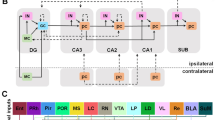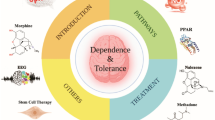Abstract
Brain-derived neurotrophic factor (BDNF) plays a role in mediating molecular, cellular, and behavioral adaptations underlying drug addiction. Here, we examined the influence of withdrawal from repeated morphine treatment on the expression of BDNF mRNA in the ventral tegmental area (VTA) and locus coeruleus (LC) of the rat brain. We also studied whether alternations in mRNA levels of BDNF in these tissues are associated with histone modifications around promoters II and III of the BDNF gene. Thus, chromatin immunoprecipitation (CHIP) and quantitative (q)-PCR were employed to assess acetylation of histone H3 at K9/K14 and trimethylation of histone H3 at K9. Results of qRT-PCR showed that levels of BDNF mRNA in both VTA and LC were significantly increased 7 days rather than 2 h or 24 h following the last injection of morphine. Consistently, CHIP and qPCR analysis revealed that on day 7 of morphine abstinence, both VTA and LC levels of histone methylation at BDNF promoters II and III of morphine treated rats were significantly lower than control animals. Morphine withdrawal caused only a significant increase in H3 acetylation at the promoter II in the LC. These data demonstrate the involvement of histone H3 methylation in the regulation of gene expression in the VTA and LC of rats during forced abstinence of morphine.


Similar content being viewed by others
References
Koob GF, Sanna PP, Bloom FE (1998) Neuroscience of addiction. Neuron 21:467–476
Nestler EJ (2001) Molecular basis of long-term plasticity underlying addiction. Nat Rev Neurosci 2:119–128
Robinson TE, Kolb B (2004) Structural plasticity associated with exposure to drugs of abuse. Neuropharmacology 47(Suppl 1):33–46
Seroogy KB, Lundgren KH, Tran TM, Guthrie KM, Isackson PJ, Gall CM (1994) Dopaminergic neurons in rat ventral midbrain express brain-derived neurotrophic factor and neurotrophin-3 mrnas. J Comp Neurol 342:321–334
Numan S, Seroogy KB (1999) Expression of trkb and trkc mrnas by adult midbrain dopamine neurons: a double-label in situ hybridization study. J Comp Neurol 403:295–308
Bolanos CA, Nestler EJ (2004) Neurotrophic mechanisms in drug addiction. Neuromolecular Med 5:69–83
Kumar A, Choi KH, Renthal W, Tsankova NM, Theobald DE, Truong HT, Russo SJ, Laplant Q, Sasaki TS, Whistler KN, Neve RL, Self DW, Nestler EJ (2005) Chromatin remodeling is a key mechanism underlying cocaine-induced plasticity in striatum. Neuron 48:303–314
Nestler EJ, Aghajanian GK (1997) Molecular and cellular basis of addiction. Science 278:58–63
Seroogy KB, Gall CM (1993) Expression of neurotrophins by midbrain dopaminergic neurons. Exp Neurol 124:119–128
King VR, Michael GJ, Joshi RK, Priestley JV (1999) Trka, trkb, and trkc messenger rna expression by bulbospinal cells of the rat. Neuroscience 92:935–944
Numan S, Lane-Ladd SB, Zhang L, Lundgren KH, Russell DS, Seroogy KB, Nestler EJ (1998) Differential regulation of neurotrophin and trk receptor mrnas in catecholaminergic nuclei during chronic opiate treatment and withdrawal. J Neurosci 18:10700–10708
McQuown SC, Wood MA (2010) Epigenetic regulation in substance use disorders. Curr Psychiatry Rep 12:145–153
Robison AJ, Nestler EJ (2011) Transcriptional and epigenetic mechanisms of addiction. Nat Rev Neurosci 12:623–637
Li B, Carey M, Workman JL (2007) The role of chromatin during transcription. Cell 128:707–719
Renthal W, Nestler EJ (2009) Chromatin regulation in drug addiction and depression. 11:257–268
Hall FS, Drgonova J, Goeb M, Uhl GR (2003) Reduced behavioral effects of cocaine in heterozygous brain-derived neurotrophic factor (bdnf) knockout mice. Neuropsychopharmacology 28:1485–1490
Sadri-Vakili G, Kumaresan V, Schmidt HD, Famous KR, Chawla P, Vassoler FM, Overland RP, Xia E, Bass CE, Terwilliger EF, Pierce RC, Cha JH (2010) Cocaine-induced chromatin remodeling increases brain-derived neurotrophic factor transcription in the rat medial prefrontal cortex, which alters the reinforcing efficacy of cocaine. J Neurosci 30:11735–11744
Vargas-Perez H, Ting AKR, Walton CH, Hansen DM, Razavi R, Clarke L, Bufalino MR, Allison DW, Steffensen SC, van der Kooy D (2009) Ventral tegmental area bdnf induces an opiate-dependent-like reward state in naive rats. Science 324:1732–1734
Horger BA, Iyasere CA, Berhow MT, Messer CJ, Nestler EJ, Taylor JR (1999) Enhancement of locomotor activity and conditioned reward to cocaine by brain-derived neurotrophic factor. J Neurosci 19:4110–4122
Lu L, Dempsey J, Liu SY, Bossert JM, Shaham Y (2004) A single infusion of brain-derived neurotrophic factor into the ventral tegmental area induces long-lasting potentiation of cocaine seeking after withdrawal. J Neurosci 24:1604–1611
Badiani A, Belin D, Epstein D, Calu D, Shaham Y (2011) Opiate versus psychostimulant addiction: the differences do matter. Nat Rev Neurosci 12:685–700
Ammon S, Mayer P, Riechert U, Tischmeyer H, Hollt V (2003) Microarray analysis of genes expressed in the frontal cortex of rats chronically treated with morphine and after naloxone precipitated withdrawal. Brain Res Mol Brain Res 112:113–125
Hatami H, Oryan S, Semnanian S, Kazemi B, Bandepour M, Ahmadiani A (2007) Alterations of bdnf and nt-3 genes expression in the nucleus paragigantocellularis during morphine dependency and withdrawal. Neuropeptides 41:321–328
Paxinos GWC (1998) The rat brain in stereotaxic. Academic Press, San Diego
Zou J, Crews F (2006) Creb and nf-kappab transcription factors regulate sensitivity to excitotoxic and oxidative stress induced neuronal cell death. Cell Mol Neurobiol 26:385–405
Tsankova NM, Kumar A, Nestler EJ (2004) Histone modifications at gene promoter regions in rat hippocampus after acute and chronic electroconvulsive seizures. J Neurosci 24:5603–5610
Wan L, Xie Y, Su L, Liu Y, Wang Y, Wang Z (2011) Rack1 affects morphine reward via bdnf. Brain Res 1416:26–34
Liang J, Zheng X, Chen J, Li Y, Xing X, Bai Y (2011) Roles of bdnf, dopamine d(3) receptors, and their interactions in the expression of morphine-induced context-specific locomotor sensitization. Eur Neuropsychopharmacol 21:825–834
Yamada K, Mizuno M, Nabeshima T (2002) Role for brain-derived neurotrophic factor in learning and memory. Life Sci 70:735–744
Tyler WJ, Alonso M, Bramham CR, Pozzo-Miller LD (2002) From acquisition to consolidation: On the role of brain-derived neurotrophic factor signaling in hippocampal-dependent learning. Learn Mem 9:224–237
Pruunsild P, Kazantseva A, Aid T, Palm K, Timmusk T (2007) Dissecting the human bdnf locus: bidirectional transcription, complex splicing, and multiple promoters. Genomics 90:397–406
McClung CA, Nestler EJ, Zachariou V (2005) Regulation of gene expression by chronic morphine and morphine withdrawal in the locus ceruleus and ventral tegmental area. J Neurosci 25:6005–6015
Grimm JW, Lu L, Hayashi T, Hope BT, Su TP, Shaham Y (2003) Time-dependent increases in brain-derived neurotrophic factor protein levels within the mesolimbic dopamine system after withdrawal from cocaine: implications for incubation of cocaine craving. J Neurosci 23:742–747
Chu NN, Zuo YF, Meng L, Lee DY, Han JS, Cui CL (2007) Peripheral electrical stimulation reversed the cell size reduction and increased bdnf level in the ventral tegmental area in chronic morphine-treated rats. Brain Res 1182:90–98
Maze I, Feng J, Wilkinson MB, Sun H, Shen L, Nestler EJ (2011) Cocaine dynamically regulates heterochromatin and repetitive element unsilencing in nucleus accumbens. Proc Natl Acad Sci USA 108:3035–3040
Kurdistani SK, Tavazoie S, Grunstein M (2004) Mapping global histone acetylation patterns to gene expression. Cell 117:721–733
Pokholok DK, Harbison CT, Levine S, Cole M, Hannett NM, Lee TI, Bell GW, Walker K, Rolfe PA, Herbolsheimer E, Zeitlinger J, Lewitter F, Gifford DK, Young RA (2005) Genome-wide map of nucleosome acetylation and methylation in yeast. Cell 122:517–527
Maze I, Nestler EJ (2011) The epigenetic landscape of addiction. Ann N Y Acad Sci 1216:99–113
Renthal W, Nestler EJ (2008) Epigenetic mechanisms in drug addiction. Trends Mol Med 14:341–350
Jing L, Luo J, Zhang M, Qin WJ, Li YL, Liu Q, Wang YT, Lawrence AJ, Liang JH (2011) Effect of the histone deacetylase inhibitors on behavioural sensitization to a single morphine exposure in mice. Neurosci Lett 494:169–173
Acknowledgments
This paper has been extracted from the Ph.D thesis of Farideh Jalali Mashayekhi and was supported by Grant Number 4269 from Vice-chancellor for Research Affairs of Shiraz University of Medical Sciences. We acknowledge the cooperation of Dr Nader Tanideh from the Stem Cell and Transgenic Technology Research Center, Shiraz University of Medical Sciences, Shiraz-Iran.
Author information
Authors and Affiliations
Corresponding author
Rights and permissions
About this article
Cite this article
Jalali Mashayekhi, F., Rasti, M., Rahvar, M. et al. Expression Levels of the BDNF Gene and Histone Modifications Around Its Promoters in the Ventral Tegmental Area and Locus Ceruleus of Rats During Forced Abstinence from Morphine. Neurochem Res 37, 1517–1523 (2012). https://doi.org/10.1007/s11064-012-0746-9
Received:
Revised:
Accepted:
Published:
Issue Date:
DOI: https://doi.org/10.1007/s11064-012-0746-9




